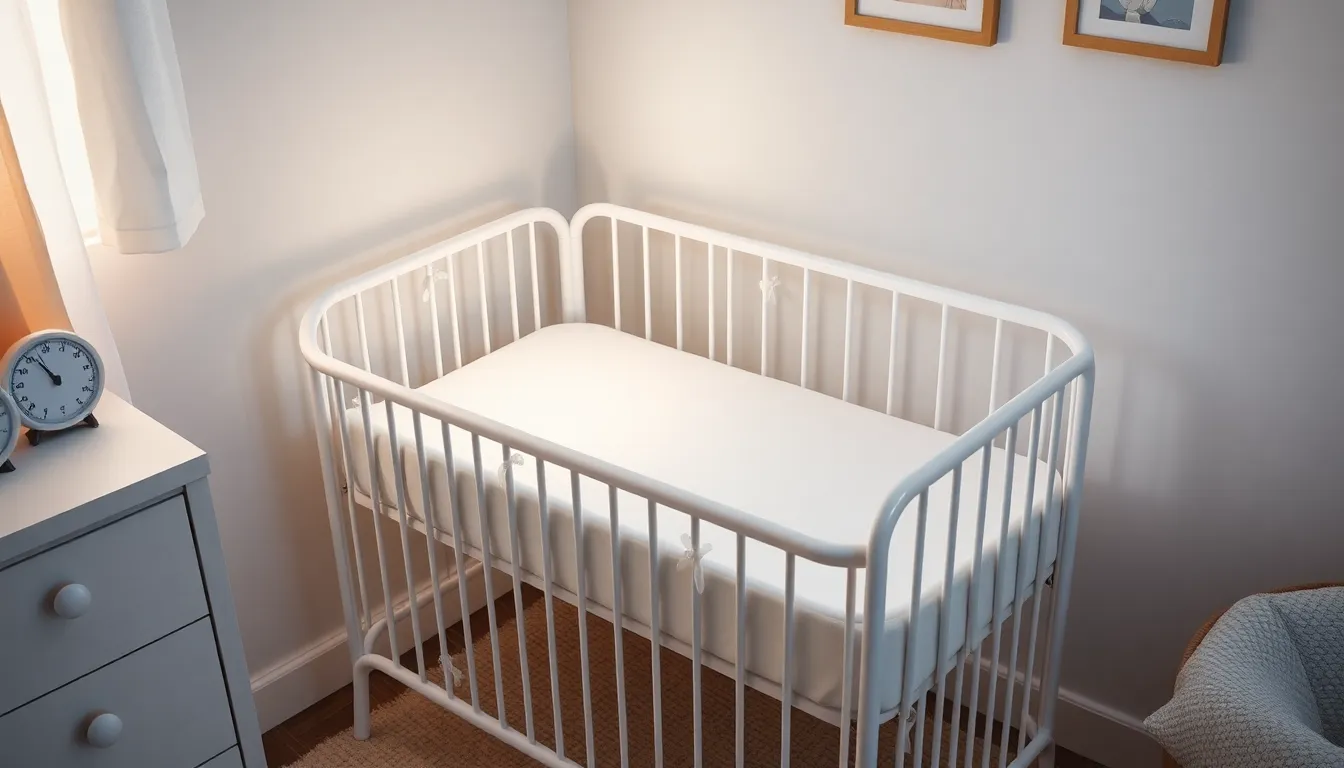Table of Contents
ToggleGetting a newborn to sleep in a bassinet can feel like trying to convince a cat to take a bath—nearly impossible! New parents often find themselves in a game of musical chairs, where the bassinet is the last seat left, and the baby just refuses to sit down. But fear not! With a few clever strategies, parents can turn that bassinet into a cozy haven rather than a bouncy castle of sleepless nights.
Understanding Newborn Sleep Patterns
Newborns typically sleep between 14 to 17 hours a day, but this sleep occurs in short bouts. Unlike adults, they cycle through light and deep sleep more quickly, averaging 50 to 60 minutes per cycle. Frequent awakenings are common as their stomachs are small, requiring feedings every two to three hours.
Sleep patterns also vary by age. Newborns, for instance, have erratic sleeping habits. They often confuse day and night, making it crucial for parents to create a conducive sleep environment. Dim lighting during night feedings helps signal that it’s time to sleep.
Establishing a bedtime routine can be beneficial. A consistent sequence of activities before sleep—like a warm bath or soft lullabies—promotes relaxation. Eventually, these routines help babies understand when it’s time to sleep.
Cues from newborns indicate their readiness for sleep. Yawning, rubbing eyes, or becoming fussy are signs to watch for. Responding promptly to these cues can ease the transition to the bassinet.
Creating a comfortable sleeping space plays a significant role in promoting better sleep. A firm mattress, appropriate swaddling, and gentle rocking can enhance the bassinet’s appeal. Recognizing and adjusting to their unique sleep needs leads to better outcomes.
Overall, understanding a newborn’s sleep patterns enables parents to employ effective strategies. Adapting to these rhythms creates a nurturing environment, making bedtime a smoother process in the bassinet.
Preparing the Bassinet

Preparing the bassinet sets the stage for a successful sleep environment for the newborn. Key considerations include location and bedding choices.
Choosing the Right Location
Positioning the bassinet in a quiet, dimly lit area enhances the baby’s sleep quality. Placing it within arm’s reach allows parents quick access during nighttime feedings and diaper changes. Families should choose a location away from noise, such as loud appliances or traffic, to minimize disruptions. Adjusting room temperature between 68°F and 72°F provides a comfortable atmosphere. Ensuring proper airflow helps prevent overheating, promoting safer sleep for the baby.
Selecting the Right Bedding
Selecting appropriate bedding contributes to a safe and comfy sleeping space for the newborn. A firm mattress that fits snugly in the bassinet is essential for reducing the risk of suffocation. Choosing a fitted sheet made from breathable fabrics aids in temperature regulation and comfort. Avoiding soft items like pillows and loose blankets ensures safety while allowing the baby to sleep soundly. Swaddling in lightweight fabric can help babies feel secure without overbundling.
Establishing a Bedtime Routine
Creating a bedtime routine establishes a calming environment for a newborn to transition smoothly to sleep in a bassinet.
Consistency is Key
Consistency offers reassurance to newborns. Following a set schedule, like bathing and reading each night, signals to the baby that it’s time to sleep. Parents can choose a specific time each evening to begin these activities, helping regulate their baby’s internal clock. Repeating this routine nightly fosters familiarity, easing the transition into the bassinet. Responding to sleep cues, such as yawning or fussiness, ensures the baby gets adequate rest. Sticking to the same order of activities promotes predictability, which can comfort the newborn.
Soothing Techniques
Soothing techniques effectively calm a baby before bed. Gentle rocking in the arms can help lull the baby into sleep. Playing soft lullabies or white noise creates a serene ambiance that encourages relaxation. Engaging in skin-to-skin contact offers added comfort and warmth, enhancing the baby’s sleep experience. Swaddling snugly can provide feelings of security, mimicking the womb environment. Dim lighting during the routine signals bedtime, while a comfortable room temperature between 68°F and 72°F supports better sleep conditions.
Creating a Sleep-Friendly Environment
Building a sleep-friendly environment for a newborn boosts comfort and increases the likelihood of a restful night. Parents can implement specific strategies to enhance their baby’s sleep space.
Dim Lighting and White Noise
Soft lighting supports a calming atmosphere. Utilize blackout curtains to reduce light and create a cozy, darkened space for sleep. Additionally, white noise machines produce gentle sounds that can mimic the womb environment. These sounds mask unexpected noises, which might startle a newborn and interrupt sleep. Choosing continuous, soothing sounds creates a familiar ambiance, encouraging deeper sleep. Many parents find that consistent use of white noise leads to longer sleep durations in their baby.
Maintaining a Comfortable Temperature
A comfortable temperature is vital for sleep. The ideal range for a newborn’s sleeping space falls between 68°F and 72°F. Parents should check the room temperature using a simple thermometer. Dressing the baby in light layers can help regulate body heat. Avoiding heavy blankets or quilts decreases the risk of overheating. Parents can also create airflow through an open window or a fan, aiding in temperature control. Ensuring a comfy temperature directly contributes to better sleep quality for their little one.
Common Challenges and Solutions
New parents face various challenges when trying to get their newborn to sleep in a bassinet. Frequent awakenings can frustrate caregivers since newborns typically sleep 14 to 17 hours a day with short bouts in between. Parents often deal with a small window for sleep, and responding to cues like yawning or fussiness becomes crucial.
Creating a conducive sleep environment addresses some of these issues. Setting the bassinet in a quiet and dimly lit area not only supports peaceful sleep but ensures easy access for nighttime feedings. Temperatures should remain between 68°F and 72°F to create a comfortable atmosphere.
Choosing the right bedding plays a significant role in enhancing comfort. A firm mattress along with breathable fitted sheets helps promote safety during sleep. Avoiding soft items like blankets and stuffed toys further ensures a secure sleeping space and aligns with safety recommendations.
Establishing a consistent bedtime routine holds value in helping newborns transition to sleep. Techniques like warm baths, gentle rocking, or soft lullabies introduce relaxation. Following the routine consistently provides infants with reassurance and supports their internal clock regulation.
Using soothing elements creates a sleep-friendly environment as well. Dim lighting and white noise machines mask unexpected sounds and maintain the calmness of the room. Dressing the baby in light layers while ensuring proper airflow enhances comfort during sleep.
Exploring these common challenges and implementing specific solutions allows parents to create a more peaceful sleeping experience for their newborns.
Establishing a peaceful sleep environment for a newborn can significantly impact both baby and parent. By implementing effective strategies and creating a consistent bedtime routine, parents can ease the transition to the bassinet.
Paying attention to sleep cues and ensuring a comfortable atmosphere will help foster better sleep habits. With patience and persistence, parents can transform their newborn’s sleep experience, leading to more restful nights and happier days. Embracing these tips can make all the difference in achieving a harmonious sleep routine for the entire family.




